Nearly extinct American chestnut – a vision from America’s past – at UW Arboretum
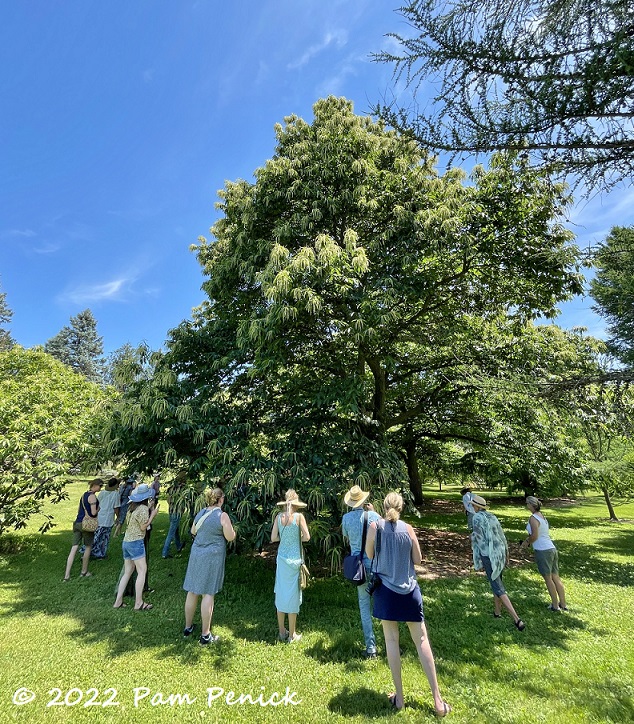
I was lagging behind, catching up with a friend as my fellow bloggers hotfooted it after our fast-talking and even faster-walking tour guide at UW Arboretum, a stop on the Madison Garden Bloggers Fling. Time was short, and the guide was beelining to noteworthy trees. During one pause he glanced at his watch and then turned quickly, telling us he had something special to show us, a tree he’d noticed blooming earlier that day.
It was an American chestnut. Castanea dentata. My eyes lifted to it in amazement as we gathered around. The American chestnut, once the king of the great Eastern forests, is now virtually extinct, wiped out by blight 100 years ago. The poetic and heartbreaking description of the chestnut’s heyday and decline in the wonderful novel The Overstory had pierced my heart when I read it. And now here I was, gazing at a survivor.
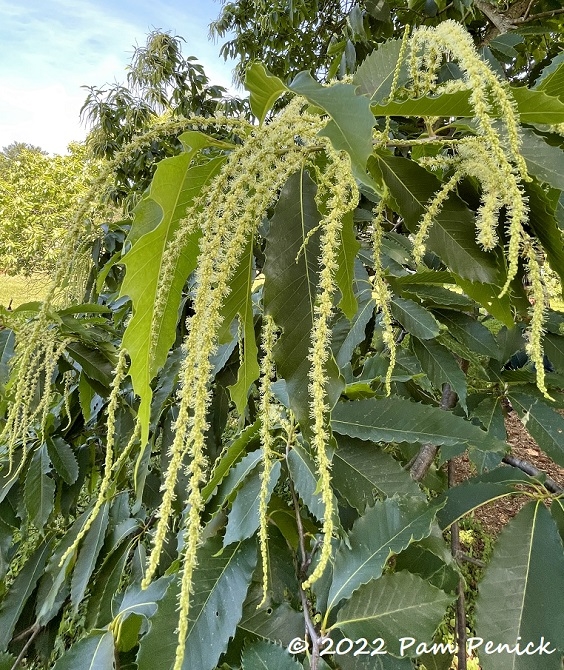
Why had the blight not killed this tree? (Not yet, one might add.)
Isolation.
This tree grows far from the American chestnut’s original range, where blight spores linger and eventually infect saplings that still rise from the stumps of old, stricken trees. Birds and pollinators can carry blight spores long distances too. But so far this lonely chestnut has remained safe. It lacks the grand stature of a mature chestnut, but it’s a good-sized tree. I hope it continues to evade the blight.
Our guide told us that the male catkins, which dangle among the toothy leaves like ivory-yellow tassels, light up a chestnut from above — like floral fireworks. Imagine a whole forest of these pale blossoms swaying in the breeze. It’s a vision that no longer exists except in stories about America’s past.
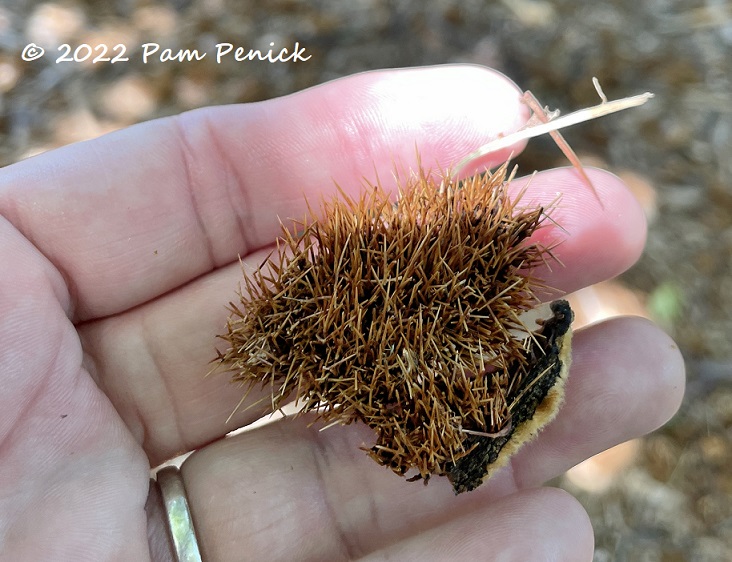
I noticed prickly burrs on the ground under the canopy and picked one up. It poked my unwary fingers. This is the remnant of a female flower, which appears on the same tree as the male catkins. If pollination occurs — which requires cross-pollination with another chestnut tree — two or three nuts form inside the female flower’s protective burr. Sharp spines safeguard the nuts until they ripen, at which time the burrs split open and fall from the tree, revealing the edible bounty within.
I can’t recall if our guide told us whether this tree ever produces nuts — if there is another lonely American chestnut near enough for pollinators to find both of them. But this one, at least, flowers each June, hoping.
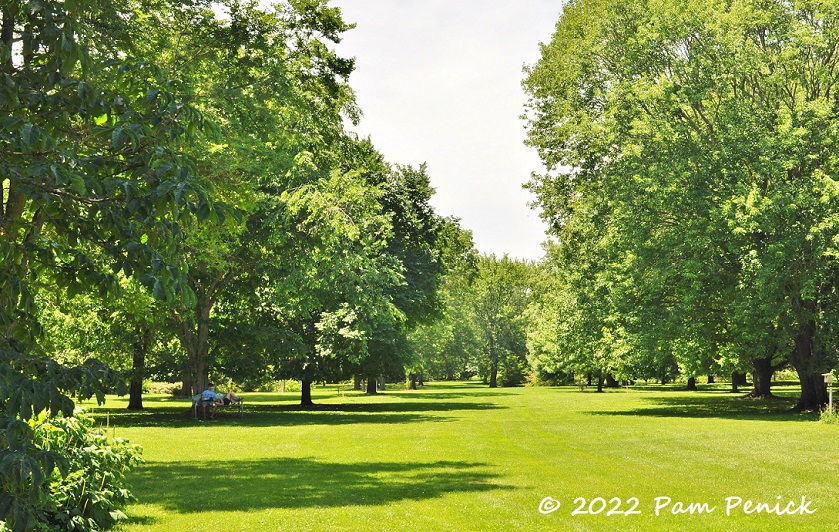
Maybe somewhere out there is another American chestnut, one far enough from the blight zone, or resistant to it…
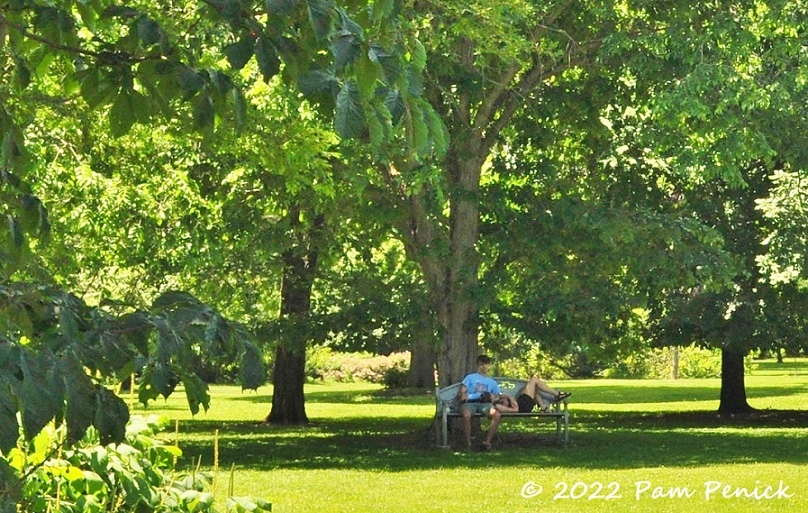
…looking for love too.
Up next: Conifers, a waterlily pond, and a sunny crevice garden at Allen Centennial Garden. For a look back at Linda Grosz’s prairie garden for wildlife, click here.
__________________________
Digging Deeper
Come learn about gardening and design at Garden Spark! I organize in-person talks by inspiring designers, landscape architects, authors, and gardeners a few times a year in Austin. These are limited-attendance events that sell out quickly, so join the Garden Spark email list to be notified in advance; simply click this link and ask to be added. Season 8 kicks off in fall 2024. Stay tuned for more info!
All material © 2025 by Pam Penick for Digging. Unauthorized reproduction prohibited.


The Arb is such a fabulous resource for us as well as favorite place to chill. We went there so often when we started gardening looking at trees and shrubs to see their mature size.
I bet it IS a terrific resource, for all those reasons.
I’ve never seen an American Chestnut tree–glad you got to see one! The long chestnut–along with all the other trees featured in “The Overstory” certainly had a poignant story, didn’t it?
I was so moved by that book and continue to think about what it says about us as a species in a changing world.
A fascinating post, as always, Pam. Now I wish I’d been out there with you for the tours. Sounds like you had some nifty discoveries. 🙂
We did, and if I’d been paying attention earlier I’m sure I would have learned even more. 😉
I just finished The Overstory and immediately thought of it when I read your blog’s subject line. I actually listened to the audio book; Susan Toren did an incredible job bringing each character to life. What a moving and frankly heartbreaking work.
It really is both heartbreaking and incredibly moving. There may be only slender hope for the human race, but life goes on.
Pam – I have a hundred year old sycamore in front of my house. There are not many in our area. It is wonderful that there are some of these majestic trees still in existence.
How wonderful, Pat, that you get to be its caretaker and enjoy that majestic old tree.
Believe there is another American Chestnut in arboretum in Tacoma WA, remember metro parks in name and it was planted about 1895 so may be larger if it survives. A blight tolerant type of American chestnut has been developed which may be approved for the Eastern US sometime soon but don’t know if it could be sent to Washington State, think they have a quarantine. The chestnut bur protects up to 3 chestnuts. Lovely photo of chestnut tree and catkins and leaves!
That’s good to hear. Thanks, Daphne.
We are lucky enough to live on a street in old north Tacoma that is dominated by a huge American Chestnut tree that is easily 130 feet tall. It likely dates from the late 19th century, which is when the houses in this area were built. It is majestic and it is s wonderful thing to consider that is probably now more than twice my age and that it will likely outlive me.
A tree like that is a treasure. Long may it grow!